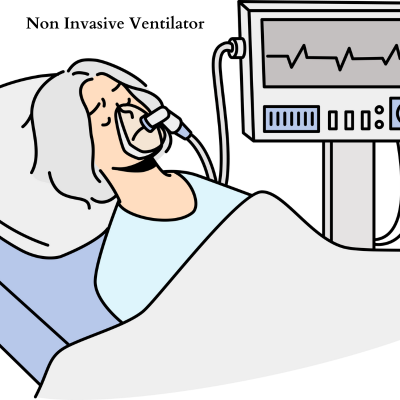Ventilators are life-saving equipment that play an important role in healthcare, especially in treating patients who cannot breathe on their own. Whether you are in biomedical or nursing, as a beginner it is important to understand how they work, parts of ventilators and best practices that can help ensure patient safety and quality care. Although many advancements have been made in ventilator technology but, In this blog you’ll find a simple beginner’s guide to ventilators that covers everything from types to troubleshooting alarms.

Table of Contents
1. What is a Ventilator?
Ventilator is a device that helps patient to breathe by delivering oxygen rich air into the lungs and removing carbon dioxide. It is used in intensive care units (ICUs), Emergency settings for patients facing various medical conditions such as :
- Respiratory Failure
- Chronic obstructive pulmonary disease (COPD)
- Pneumonia
- Acute respiratory distress syndrome (ARDS)
- Neurological disorders
2. Types of Ventilators
There are two main types of ventilators: invasive and non-invasive.
- Invasive Ventilators: These ventilators are connected to a patient through an endotracheal tube or tracheostomy, typically used in ICU settings for patients who cannot breathe on their own.
- Non-Invasive Ventilators: These ventilators use masks or other interfaces (e.g., BiPAP (Bilevel Positive Airway Pressure ), CPAP (Continuous Positive Airway Pressure)) to assist breathing without invasive procedures, commonly used in sleep apnea and respiratory conditions.


3. How Ventilators Work : Basic Key Terms
Understanding the basic key terms of ventilators can make it easier to monitor and adjust them. Ventilators deliver air by creating positive pressure which help patients to inhale and exhale. Key terms to understand :
- Tidal Volume: The amount of air delivered to the lungs with each breath.
- Fraction of Inspired Oxygen (FiO2) – percentage of oxygen delivered to the patient
- Respiratory Rate (RR) – number of breaths per minute
- Positive End Expiratory Pressure (PEEP) – positive pressure that remains in the lungs throughout expiration to keep alveoli open
- I:E ratio – ration of time between inspiration and expiration
4. Main Parts of Ventilator and What Each Part Does
- Patient Circuit : Delivers oxygen rich air from the ventilator to Patient.
- Monitor : Display Patient data like respiratory rate (RR),Tidal Volume,Fraction of Inspired Oxygen (FiO2)., etc., and allows healthcare professionals to set ventilation parameters.
- Humidifier : Adds moisture to the air to prevent irritation (dryness) to the respiratory tract.
- Sensors & Alarms : Sensors do Monitor patient data, ventilation parameters and alarm system alerts healthcare professionals about any abnormal signs.
5. Basic Ventilator Settings Every Beginner Should Know
- Respiratory Rate (RR): Breaths per minute (bpm)
- Range: 10-40 bpm
- Tidal Volume (TV): Volume of air per breath (mL)
- Range: 400-800 mL (adults), 100-300 mL (pediatrics)
- FiO2 (Fraction of Inspired Oxygen): Oxygen percentage Range : 21-100%
- Positive End-Expiratory Pressure (PEEP): Pressure during exhalation (cmH2O)
- Range: 5-20 cmH2O
- Inspiratory Pressure (IP): Pressure during inhalation (cmH2O)
- Range: 10-40 cmH2O
- Volume and Pressure Settings : Regulates how much air and pressure the ventilator delivers with each breath.
6. Common Alarms and Troubleshooting guide
Ventilator alarms indicate potential issues that need attention. Common alarms include:
- High/Low Pressure Alarm : Generally High pressure indicates an obstruction or too much pressure in the airway. Low Pressure indicates disconnection or leak in the system
- Low Volume Alarm (e.g., low VT(tidal volume)/MV(Minute Volume)) : It indicates low volume delivered to the patient.
- Apnea Alarm : It indicates when patient stops breathing for a set time.
Each alarm serves as a signal for healthcare providers to check connections, settings, or patient conditions. Basic troubleshooting often includes reconnecting tubing, checking for kinks, fixing mask properly or checking ET tube leakage and adjusting settings.
7. Safety Tips and Best Practices which ensure quality care for Beginners Using Ventilators
- Regular Monitoring : Frequently checking of device and patient.
- Infection Control Practices : Follow Infection control protocol strictly. (e.g., regular replacement of inspiratory and expiratory filters, hygiene practices)
- Maintenance of Equipment : Regularly clean and inspect ventilator components to ensure they function correctly.
Conclusion
Understanding ventilators, from their types and basic functions to troubleshooting alarms, is essential for anyone working in healthcare. By familiarizing yourself with these basics, you’ll be better equipped to provide safe, effective care to patients who rely on these critical devices. Keep learning and practicing to build your skills with ventilators over time!
